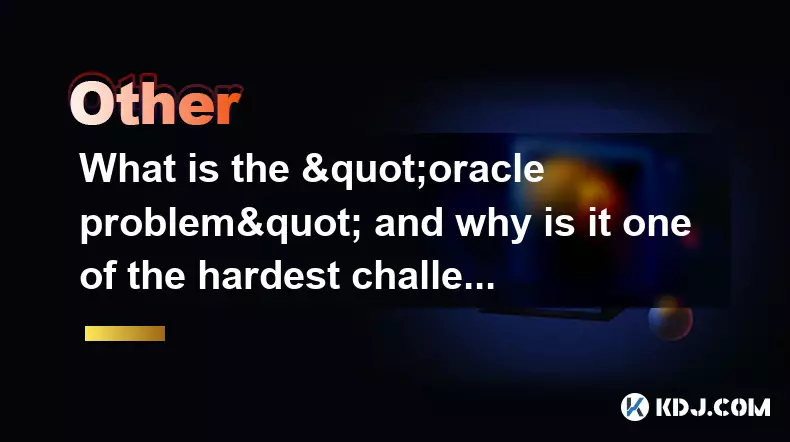-
 bitcoin
bitcoin $103128.103252 USD
-3.33% -
 ethereum
ethereum $3437.127692 USD
-4.86% -
 tether
tether $0.999700 USD
-0.02% -
 xrp
xrp $2.403993 USD
-5.73% -
 bnb
bnb $961.374676 USD
-4.11% -
 solana
solana $154.938665 USD
-8.18% -
 usd-coin
usd-coin $1.000113 USD
0.03% -
 tron
tron $0.298122 USD
0.30% -
 dogecoin
dogecoin $0.172428 USD
-5.76% -
 cardano
cardano $0.557625 USD
-7.13% -
 hyperliquid
hyperliquid $38.740701 USD
-6.51% -
 chainlink
chainlink $15.306051 USD
-7.51% -
 bitcoin-cash
bitcoin-cash $507.558648 USD
-3.26% -
 stellar
stellar $0.281899 USD
-6.74% -
 unus-sed-leo
unus-sed-leo $9.241811 USD
0.57%
What is the "oracle problem" and why is it one of the hardest challenges in blockchain?
The oracle problem undermines blockchain's decentralization by relying on external data sources that can be manipulated, creating single points of failure in smart contracts.
Nov 09, 2025 at 11:00 am

The Oracle Problem in Blockchain
1. The oracle problem refers to the challenge of securely connecting blockchains with real-world data. Blockchains operate in isolated environments and cannot natively access information outside their network. When smart contracts require external data—such as stock prices, weather conditions, or sports results—they depend on intermediaries known as oracles to deliver this information.
2. Oracles act as bridges between on-chain and off-chain data sources. However, introducing a third-party service undermines one of blockchain’s core principles: decentralization. If an oracle is compromised, manipulated, or fails to deliver accurate data, the smart contract relying on that input may execute incorrectly, leading to financial loss or systemic failure.
3. Centralized oracles pose significant risks because they represent single points of failure. A malicious actor gaining control over such an oracle could feed false data into a blockchain system. This is particularly dangerous in decentralized finance (DeFi) applications where millions of dollars in assets are governed by automated contracts dependent on price feeds.
4. Even if an oracle is honest, latency, downtime, or inaccuracies in data reporting can disrupt operations. For instance, a delayed price update in a lending protocol might trigger incorrect liquidations, harming users and damaging trust in the platform.
5. The integrity of the entire smart contract ecosystem hinges on reliable data inputs. Without a trustworthy mechanism to verify and transmit real-world events, blockchain applications remain vulnerable regardless of how secure their internal logic may be.
Why the Oracle Problem Is So Difficult to Solve
1. Trust minimization is a foundational goal of blockchain technology. Yet oracles inherently reintroduce trusted parties, creating a contradiction. Designing a system that maintains decentralization while sourcing external data is extremely complex.
2. Data authenticity is hard to guarantee. Unlike on-chain transactions that are cryptographically verifiable, off-chain data lacks native proof of validity. Determining whether a temperature reading, election result, or market price is genuine requires reliance on external verification mechanisms that may not be tamper-proof.
3. Achieving consensus across multiple oracles introduces coordination overhead and potential attack vectors. While some solutions aggregate data from several sources to reduce manipulation risk, attackers can still target enough nodes to skew the outcome, especially if incentives are misaligned.
p>4. Economic models for incentivizing honest behavior among oracle operators are still evolving. If rewards for providing data are too low, participation drops; if they’re too high, they attract bad actors seeking to exploit the system. Balancing these incentives without central oversight remains a persistent challenge.
5. Real-time data demands further complicate matters. Many applications require up-to-the-second updates, but frequent queries increase costs and strain network resources. Ensuring timely, accurate, and affordable data delivery at scale has yet to be fully resolved.
Current Approaches and Their Limitations
1. Chainlink pioneered decentralized oracle networks by aggregating data from multiple independent providers. While this improves reliability, it still depends on the honesty and security of those providers. Compromised nodes or colluding participants can distort results.
2. Some platforms use reputation systems to rank oracle performance. However, reputation can be gamed, and historical accuracy does not guarantee future integrity. A previously trusted node might turn malicious under the right incentive.
3. Hybrid models combining on-chain verification with off-chain computation offer partial improvements but do not eliminate dependency on external inputs. These systems often shift rather than solve the trust issue, requiring users to accept new assumptions about data origin and transmission.
4. Trusted execution environments (TEEs), like Intel SGX, aim to secure data processing within hardware-isolated zones. However, vulnerabilities in TEE implementations have been exposed, and reliance on proprietary hardware contradicts open, permissionless ideals.
5. Cross-chain oracle solutions attempt to validate data through interoperability between blockchains. Yet inter-chain communication itself suffers from similar trust and latency issues, multiplying complexity without offering definitive answers.
Frequently Asked Questions
What makes an oracle 'decentralized'?A decentralized oracle distributes data retrieval and validation across multiple independent nodes. Instead of relying on a single source, it aggregates inputs from various participants, reducing the risk of manipulation. However, true decentralization requires robust incentive structures and resistance to collusion.
Can blockchain eliminate the need for oracles entirely?Not for applications requiring real-world data. Purely on-chain systems can function autonomously, but any interaction with external events—like insurance payouts based on flight delays—necessitates an oracle. The goal is not elimination but mitigation of associated risks.
How do DeFi platforms handle oracle failures?Many implement circuit breakers, fallback data sources, or time-weighted average prices (TWAPs) to resist sudden data anomalies. Despite these safeguards, extreme volatility or coordinated attacks can still lead to losses, as seen in several high-profile exploits.
Disclaimer:info@kdj.com
The information provided is not trading advice. kdj.com does not assume any responsibility for any investments made based on the information provided in this article. Cryptocurrencies are highly volatile and it is highly recommended that you invest with caution after thorough research!
If you believe that the content used on this website infringes your copyright, please contact us immediately (info@kdj.com) and we will delete it promptly.
- Dogecoin, Investor, Knowledge: Navigating the Meme Coin Mania in 2025
- 2025-11-13 00:40:00
- Mississippi Retailers and the Penny Predicament: What's a Cash Customer to Do?
- 2025-11-13 01:00:02
- Hyperliquid, Aster Whales, and Zero Knowledge Proof: A New Era of Crypto?
- 2025-11-13 01:20:01
- XRP vs. Crypto Presales: Can Digitap or LivLive Deliver a 100x Return?
- 2025-11-13 01:15:01
- Hedera, Regulated Assets, and Dual Token Flexibility: A New Era for Tokenization
- 2025-11-13 01:45:01
- XRP, Cardano, and the Altcoin Arena: What's Hot Now?
- 2025-11-13 01:25:03
Related knowledge

What are intents in crypto and how do they change user interaction?
Nov 09,2025 at 09:00am
Understanding the Role of Decentralized Exchanges in Modern Crypto Trading1. Decentralized exchanges, commonly known as DEXs, have reshaped how trader...

What is restaking and how does it enhance economic security?
Nov 09,2025 at 11:40pm
Understanding Restaking in the Blockchain Ecosystem1. Restaking refers to the process where users who have already staked their tokens in a proof-of-s...

What is a sovereign rollup and how does it differ from a smart contract rollup?
Nov 10,2025 at 09:00am
Understanding Sovereign Rollups1. A sovereign rollup operates as an independent blockchain layer that leverages the data availability of a base layer,...

What is a crypto-economic system and how does it use incentives to secure a network?
Nov 11,2025 at 01:20am
Understanding Crypto-Economic Systems1. A crypto-economic system refers to the integration of cryptography, distributed systems, and economic incentiv...

What is a blockchain's throughput and how is it measured?
Nov 12,2025 at 04:00am
Understanding Blockchain Throughput1. Blockchain throughput refers to the number of transactions a blockchain network can process within a specific ti...

What is the difference between a simple payment verification (SPV) node and a full node?
Nov 12,2025 at 09:40am
Understanding the Role of Full Nodes in the Blockchain Ecosystem1. A full node downloads and verifies every block and transaction in the blockchain ac...

What are intents in crypto and how do they change user interaction?
Nov 09,2025 at 09:00am
Understanding the Role of Decentralized Exchanges in Modern Crypto Trading1. Decentralized exchanges, commonly known as DEXs, have reshaped how trader...

What is restaking and how does it enhance economic security?
Nov 09,2025 at 11:40pm
Understanding Restaking in the Blockchain Ecosystem1. Restaking refers to the process where users who have already staked their tokens in a proof-of-s...

What is a sovereign rollup and how does it differ from a smart contract rollup?
Nov 10,2025 at 09:00am
Understanding Sovereign Rollups1. A sovereign rollup operates as an independent blockchain layer that leverages the data availability of a base layer,...

What is a crypto-economic system and how does it use incentives to secure a network?
Nov 11,2025 at 01:20am
Understanding Crypto-Economic Systems1. A crypto-economic system refers to the integration of cryptography, distributed systems, and economic incentiv...

What is a blockchain's throughput and how is it measured?
Nov 12,2025 at 04:00am
Understanding Blockchain Throughput1. Blockchain throughput refers to the number of transactions a blockchain network can process within a specific ti...

What is the difference between a simple payment verification (SPV) node and a full node?
Nov 12,2025 at 09:40am
Understanding the Role of Full Nodes in the Blockchain Ecosystem1. A full node downloads and verifies every block and transaction in the blockchain ac...
See all articles










































































